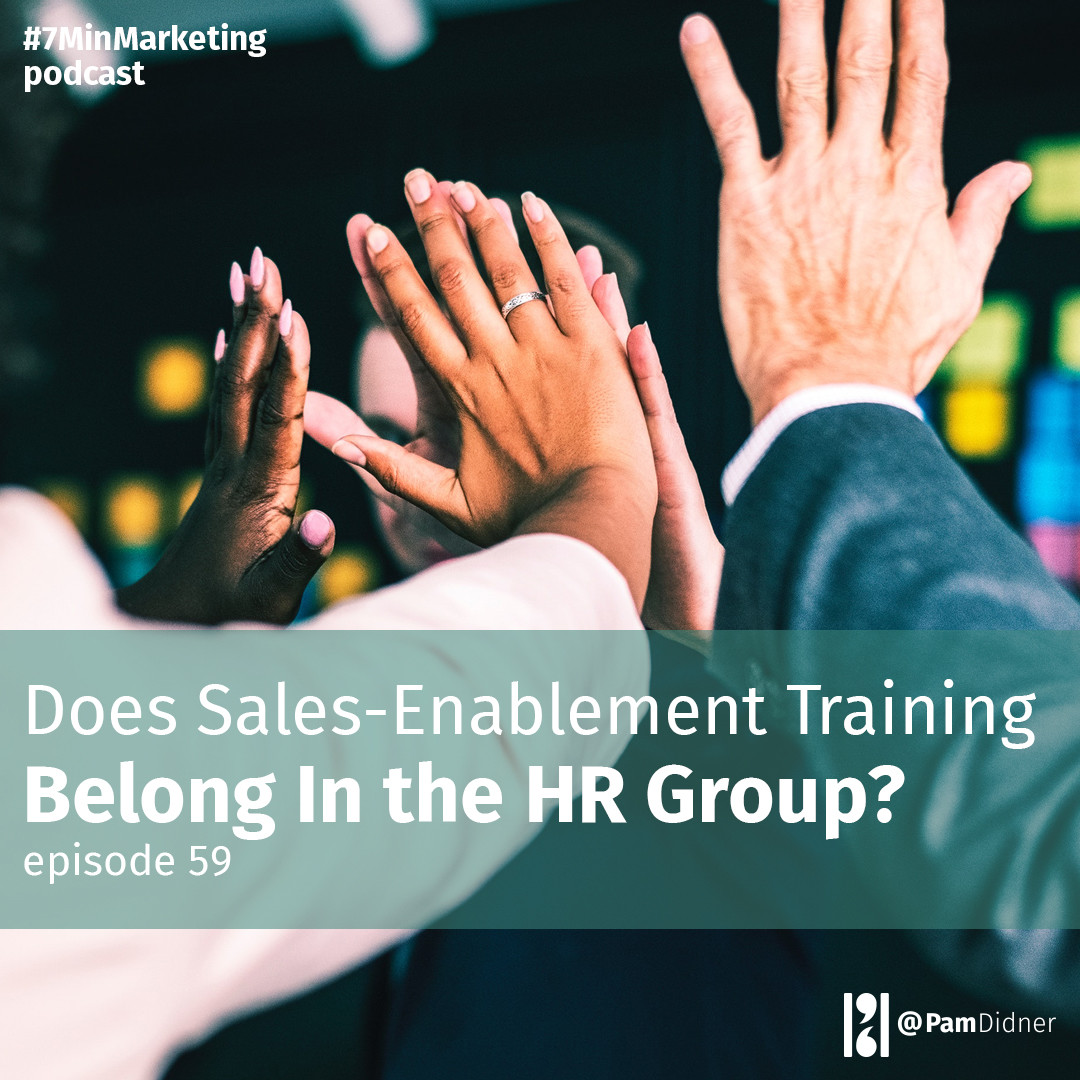
Welcome to another episode of 7-Minute Marketing with Pam. My name is Pam Didner. I love sharing a dose of B2B, digital, content marketing, and sales enablement, seven minutes at a time.
An HR manager asked me, “Pam, do you think sales-enablement training and development belong in HR?”
Well, we all know that training has been one of the core competencies provided by HR, in addition to talent recruiting, performance reviews, and pay structure.
Here is the reality, with the rise of technology, training is no longer confined to classroom settings or online courses. It can be micro-training through mobile apps with snackable doses of information pushed out daily to users. Training can be virtual and interactive hands-on through augmented reality. It can even be an on-point educational video on YouTube or topical-driven podcasts that you can listen anywhere.
In short, anyone in the company who has budget can develop some sort of training materials for their teams. Content-creation tools are readily available for everyone to use.
There are also different content-syndication platforms that enable you to easily share your training materials on any platforms. You can use Loom to record your training, then share on YouTube, via email, or any social media platform you desire. Anybody in the company can be a content creator.
Who owns sales training?
The boundaries of training roles and responsibilities between different functional groups have begun to fade with the rise of technology. It begs the question: who owns sales training? HR, sales or functional or product groups?
Conventionally, sales training tends to reside within the sales organizations. A sales-enablement manager or a sales-training manager who is responsible for sales onboarding and training may develop a continuous training regimen, from a pre-onboarding curriculum to continuous onboarding or annual refreshers and updates using different medium and technologies.
To accomplish this effectively and digitally, it may be necessary to integrate the company’s:
- email system (IT department),
- the employee-performance system (HR department)
- the training platform (Sales Enablement department)
- the content management library (Marketing department)
When salespeople complete the pre-onboarding curriculum, their managers will receive an email notification, or a management dashboard will be updated with the results. After salespeople take tests for each subject in their curriculum, the score is sent to their managers and automatically updated in their HR records.
Sales training can belong to several departments. For example, if the sales-enablement training methodology and platform being used is recognized as the best practice, then the HR department can easily argue that sales-enablement training should be folded into its responsibilities to drive corporate efficiency. The sales team can argue that sales-enablement training has unique requirements that only apply to sales and, therefore, the sales function should retain the ownership of the entire effort. The marketing team can make the case that a big chunk of sales training content comes from the marketing team, therefore, marketing should run it. Organizational structures and roles and responsibilities will continue to morph as markets, customers, buying habits, and technology evolve.
Who should own sales training?
I have seen the sales-enablement training function report to marketing, sales, sales operations, HR, and even product teams. In some companies, sales training might be put under HR because one of the more important responsibilities of sales enablement is training, and HR is responsible for hiring and training company-wide.
Amy Pence, sales-enablement manager at Alteryx, reported to the sales team. Then, her team was moved from Sales to HR to scale her best practices across the corporation. In some cases, subject-matter experts or product engineers are responsible for creating product training for the sales team. Therefore, the training function is incorporated into the product teams. Emma Hitzke, Senior Marketing Manager for Intel’s IoT division, leads a sales-enablement team that reports to one of the product groups.
So, it depends on the budget, timelines, skillsets, resources, senior management direction, and even the maturity of the sales organization. Even after taking these factors into consideration, ongoing adjustments have to be made based on a changing external environment as well as the fact that sales enablement itself is still evolving.
Even though the goal is the same, every company structures its sales-training support based on what works, or what they believe will work for them at that time. Eventually, they will probably pivot the team structure.
Ultimately, it doesn’t matter where sales training resides. The key is to foster close collaboration across departments. To share best practices and provide knowledge and tools to unleash employees’ and salespeople’s potentials.
One question answered and more to go.
Please, send me your marketing questions and thoughts here or via Twitter @pamdidner.
Be well. Keep Hustling. Until next time.



